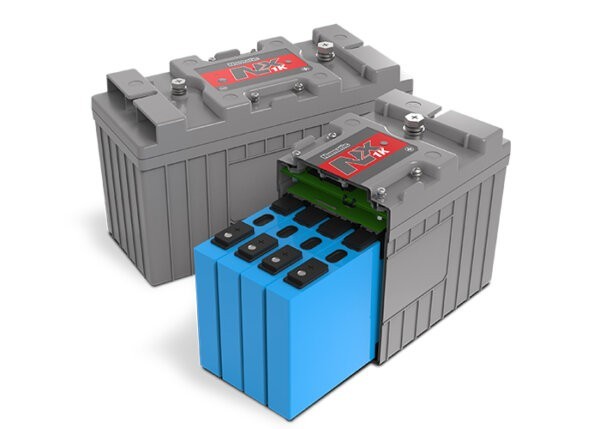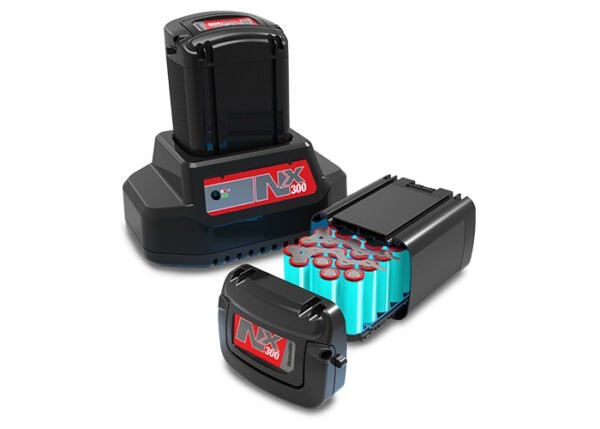Lead-Acid vs. Lithium Batteries
In the realm of energy storage, two primary categories dominate the landscape: traditional lead-acid batteries and the more contemporary lithium batteries. Each brings distinct advantages and limitations. In this comprehensive guide, we’ll unravel the disparities between these two battery technologies, focusing on Numatic’s NX1K Lithium Phosphate and NX300 Lithium-ion batteries, providing an insightful comparison to assist in making informed decisions.
What’s the Difference?
1. Lead-Acid Batteries:
Lead-acid batteries have been the workhorses in energy storage for decades. They are typically found in cars, boats, forklifts, and various backup power applications.
Let’s delve into their characteristics:
| Characteristic | Lead-Acid Batteries |
|---|---|
| Weight | Heavy |
| Volumetric Energy Density (power to weight ratio) | Low |
| Cycle Life | Short (800-1000 charge cycles) |
| Maintenance | Requires regular maintenance |
| Environmental Impact | Contains hazardous materials |
| Charge Rate | Slow |
| Cost-effectiveness | Initially cheaper |
Pros of Lead-Acid Batteries:
- Cost: Initially, lead-acid batteries are more cost-effective, making them a common choice for many applications.
- Familiarity: Their established presence in the market ensures familiarity and ease of maintenance for many users.
- Availability: Widely available and easily replaceable.
Cons of Lead-Acid Batteries:
- Weight and Size: Heavier and larger compared to lithium batteries, affecting portability and space requirements.
- Shorter Cycle Life: Typically have a shorter lifespan compared to lithium batteries, requiring more frequent replacements.
- Maintenance Requirements: Regular maintenance, such as topping up electrolytes and avoiding deep discharges, is necessary.
2a. Lithium Phosphate Batteries (NX1K)

Lithium Phosphate batteries, like Numatic’s NX1K, represent a significant evolution in battery technology, offering distinct advantages over lead-acid batteries:
| Characteristic | NX1K Lithium Phosphate Batteries |
|---|---|
| Weight | Light |
| Volumetric Energy Density (power to weight ratio) | High |
| Cycle Life | Longer (4000 Charge Cycles) |
| Maintenance | Low maintenance |
| Environmental Impact | Environmentally friendly |
| Charge Rate | Flexible and rapid |
| Cost-effectiveness | Long-term cost efficiency |
Pros of Lithium Phosphate Batteries (NX1K):
- Longer Cycle Life: Lithium Phosphate batteries offer a longer lifespan, reducing the frequency of replacements.
- Lightweight and Compact: They are lighter and more compact, allowing for increased portability and space efficiency.
- Environmental Friendliness: Lithium Phosphate batteries are environmentally friendly and recyclable.
Cons of Lithium Phosphate Batteries (NX1K):
- Higher Initial Cost: Lithium Phosphate batteries may have a higher upfront cost compared to lead-acid batteries.
2b. Lithium-ion Batteries (NX300)

Lithium-ion batteries, like Numatic’s NX300 series, represent another variant of lithium technology. They possess their own set of characteristics:
| Characteristic | NX300 Lithium-ion Batteries |
|---|---|
| Weight | Light |
| Volumetric Energy Density (power to weight ratio) | High |
| Cycle Life | Moderately high (2500 Charge Cycles) |
| Maintenance | Low maintenance |
| Environmental Impact | Moderate |
| Charge Rate | Fast |
| Cost-effectiveness | Long-term cost efficiency |
Pros of Lithium-ion Batteries (NX300):
- High Energy Density: Lithium-ion batteries offer superior energy density, providing more power in a smaller package.
- Low Maintenance: They require minimal maintenance, providing hassle-free usage.
- Faster Charging: Lithium-ion batteries typically charge faster than lead-acid batteries.
Cons of Lithium-ion Batteries (NX300):
- Moderate Environmental Impact: Lithium-ion batteries have a moderate environmental impact, with certain challenges in disposal and recycling.
Comparison Table
|
Characteristic |
Lead-Acid Batteries |
NX1K Lithium Phosphate |
NX300 Lithium-ion |
|
Weight |
Heavy |
Light |
Light |
|
Volumetric Energy Density (power to weight ratio) |
Low |
High |
High |
|
Cycle Life |
Short (800-1000 charge cycles) |
Longer (4000 charge cycles) |
Moderately high (2500 Charge cycles) |
|
Maintenance |
Requires regular maintenance |
Low Maintenance |
Low maintenance |
|
Environmental Impact |
Contains hazardous materials |
Environmentally friendly |
Moderate |
|
Charge Rate |
Slow |
Flexible and rapid |
Fast |
|
Cost-effectiveness |
Initially cheaper |
Long-term cost efficiency |
Long-term cost efficiency |